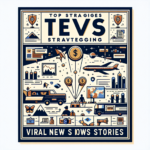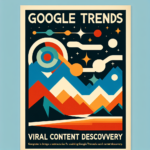“`html
Introduction
Ever wondered what exactly makes a piece of content go viral? Well, you’re not alone. In this blog post, we’ll explore the details of viral content, its defining characteristics, and the different types we often encounter in the digital space.
From videos to memes, infographics to social media challenges, we’ll discuss how these forms of content achieve viral status and why their impact resonates with a vast audience. We’ll also take a look at various platforms ideal for sharing viral content like Facebook, Twitter, Instagram, and TikTok.
Want to create your own viral content? No problem, we’ve got you covered. Follow along as we share strategies and real-world examples of success in generating viral content. So, what are we waiting for? Let’s get started with the world of viral content!
What is Viral Content?
Defining Viral Content
Viral content refers to media that becomes popular through internet sharing. It spreads quickly through platforms like social media, reaching a vast audience.
This content often provokes strong emotions, leading people to share it rapidly with others.
Characteristics of Viral Content
To identify what makes content go viral, look for these common characteristics:
- Emotional Appeal: Evokes emotions like joy, surprise, or anger.
- Relatability: Connects with the audience’s everyday experiences.
- Engagement: Encourages interaction, comments, or sharing.
- Originality: Offers a fresh perspective or creative take.
Types of Viral Content
Several forms of content can achieve viral status:
- Videos: Eye-catching visuals or innovative storytelling.
- Memes: Simple images or GIFs paired with humorous captions.
- Infographics: Data-driven content that is easy to digest.
- Challenges: Encouraging user participation on social media.
Platforms for Viral Content
Certain platforms are more effective for viral content sharing:
- Facebook: Great for diverse content types with broad reach.
- Twitter: Short, timely messages often with hashtags.
- Instagram: Image-focused content with engaging visuals.
- TikTok: Short, user-generated videos with trending music.
Consider which platform best suits your content format.
Generating Viral Content
Creating viral content involves a few strategies:
- Identify Trending Topics: Use tools like BuzzFeed to spot trends.
- Create High-Quality Visuals: Invest in good graphics or video production.
- Encourage Sharing: Use call-to-actions to prompt sharing and engagement.
Examples of Viral Success
| Content | Platform | Impact |
|---|---|---|
| Ice Bucket Challenge | Raised awareness for ALS, significant fundraising. | |
| World Record Egg | Became the most-liked Instagram post ever. |
Real-world examples illustrate how various elements can lead to viral content.
Measuring Viral Content Success
Metrics that indicate success include:
- Engagement Rate: Likes, comments, and shares.
- Reach: Total number of unique users exposed to the content.
- Conversions: Actions taken as a result of consuming the content.
Use analytics tools to track these metrics and adjust strategies accordingly.
Additional Factors Affecting Virality
Timing and Trend Alignment
To increase the chances of content going viral, the timing and alignment with current trends can play a huge role. Consistently capitalizing on the latest trends and news can increase the chances of a content piece being shared widely. Monitoring the popularity of specific subjects or stories in your industry will provide insight on what the audience is currently interested in. This information can guide your content creation and posting schedule.
The Rule of Simplicity
One common characteristic of viral content is simplicity. The concept, message, or story behind the content should be simple enough to be understood quickly and easily by the audience. Complex messages usually struggle to gain traction and become viral. According to research published on the Frontiers in Psychology, simple, unambiguous messages that can be understood and shared in a short amount of time are more likely to become viral.
Use of Influencers
An endorsement or share from an influential personality in your industry can significantly boost the spread of your content. Influencers have large and loyal followings that trust their recommendations. Therefore, if they share your content, it has a higher likelihood of going viral.
Linking to Trusted Sources
Linking your content to trusted and reliable resources can increase its credibility and sharing potential. People are more likely to share content that they perceive as trustworthy and valid.
Analyzing and Leveraging Viral Content
Audience Interpretation and Reaction
Taking note of how the audience interprets and reacts to viral content can provide invaluable insights for future content creation. Understanding what resonates with the audience and what doesn’t can guide improvements in content strategy.
Use of Viral Content to Drive Business Goals
Though viral content can garner large amounts of attention, it should ultimately serve the business’s objectives. Whether it’s driving website traffic, increasing product sales, or improving brand recognition, the content should be designed to meet these goals.
Learning from Viral Failures
Not all content will achieve virality, and that’s okay. These failures provide opportunities for learning and improvement. Analyzing why particular content pieces didn’t perform as well as expected can shed light on areas that need refinement in the content creation process.
Developing a System to Create Viral Content
Building a consistent, repeatable process for creating potential viral content can increase chances of success. This may involve brainstorming sessions, competitor content analysis, reviewing audience feedback, and many more strategies designed to generate compelling, shareable content. By honing this system, businesses can increase their chances of producing viral content.
Exploring Viral Content Formats
Text-Based Content
While videos and images often overshadow text, there are still text-based formats that can go viral. Think pieces, narrative stories, or poignant tweets have the potential to resonate deeply and be shared widely. The key is a strong, relatable message or an unexpected twist that captivates readers.
User-Generated Content
Inviting your audience to participate by creating their content around your theme not only increases engagement but also enhances your reach. This type of content thrives on platforms like TikTok and Instagram, where users can easily replicate trends and challenges, adding their unique spin.
Long-Form Content
Surprisingly, in-depth articles or comprehensive guides can also go viral if they address a popular topic or answer pressing questions with authority and depth. Such content typically gets shared for its utility, educational value, or well-researched insights. It appeals to audiences looking for expert analysis rather than just entertainment.
Interactive Content
Quizzes, polls, and other interactive formats encourage active participation from users. They often get shared as people enjoy comparing their results with friends. BuzzFeed is a big player in this space, frequently using quizzes to tap into trends and cultural phenomena.
Tools and Techniques for Creating Viral Content
Data-Driven Insights
Using analytics tools like Google Trends or BuzzSumo can help identify what’s trending in real-time, tailoring content to match audience interests. By leveraging data, creators can predict the potential for content to become highly popular based on subject matter and timing.
Content Collaboration
Partnering with other creators or brands can amplify the reach of content. Collaborations allow access to a broader audience and often bring together varied skill sets, resulting in more creative and diverse content that attracts wider attention.
Optimized Distribution
Strategically timing posts and using platform-specific optimization, like SEO for blogs or hashtags for Instagram, ensures content reaches the right audience efficiently. Scheduling tools and algorithms insights for each platform can significantly enhance the likelihood of a content piece gaining traction.
Storytelling Techniques
Stories that weave in compelling narratives and offer authentic connections tend to go viral. People are naturally drawn to stories they can relate to or that provide inspiration. This approach plays well across all formats, whether text, video, or images.
By exploring these formats and strategies, creators can increase the chances of their content achieving viral success.
Strategies to Enhance Virality
Engaging with Niche Audiences
Targeting specific niche communities can bolster your content’s chances of going viral. Engaging with niche audiences often results in higher engagement because the content is more relevant and meaningful to them. For instance, tapping into forums on Reddit or specific Facebook groups allows content to gain traction within these concentrated communities before potentially breaking into a broader audience.
Use of Humor and Satire
Humor is a powerful tool for making content shareable. Crafting content with a humorous slant or employing satire can capture attention and resonate with audiences on social media platforms. Memes are a prime example of humorous content that frequently goes viral, especially when they are timely and tackle current societal topics.
Mobile Optimization
With the majority of people accessing content through mobile devices, ensuring your content is mobile-friendly is paramount. This involves optimizing load times, ensuring readability on small screens, and using design elements that look great on mobile devices. Content that is easily viewable and sharable on mobile is more likely to receive wider engagement.
Case Studies and Real-Life Examples
Using case studies or real-life examples adds authenticity to your content. People are more inclined to share and discuss content that links to real-world scenarios they can relate to. This approach can be especially effective in blog posts, articles, or videos that aim to educate or inform.
Creating FOMO (Fear of Missing Out)
Generating a sense of urgency or exclusivity in your content can make it more shareable. Promoting limited-time events, exclusive content releases, or early access opportunities can trigger FOMO among viewers, encouraging them to engage and share quickly to not miss out.
By leveraging these strategies, you can improve the likelihood of your content gaining viral traction, aligning with the goal of achieving widespread visibility and engagement.
Wrapping it Up
In essence, viral content is digital media that gains popularity through rapid internet sharing, reaching vast audience numbers quickly. It often connects directly with viewers, provoking feelings that prompt people to share it with others. Viral content can take on many forms, including videos, memes, infographics, and user-participation challenges.
Key strategies to create viral content are identifying trending topics, creating high-quality visuals, and encouraging sharing. Additionally, it’s vital to remember that while generating vast engagement, viral content should still align with your business’s objectives.
By exploring different content formats, such as text-based content, user-generated content, interactive content, and long-form content, creators have numerous viable paths to virality. Furthermore, using tools and techniques such as data-driven insights, content collaborations, optimized distribution, and effective storytelling techniques can significantly increase the chances of viral success.
Frequently Asked Questions – FAQs
What is viral content?
Viral content refers to any media that gains massive popularity through rapid internet sharing. It mainly spreads through social media platforms and provokes strong emotions, leading viewers to share it with others.
What are some characteristics of viral content?
Viral content often appeals emotionally, carries relatability, encourages engagement, and presents originality. It’s also easily understood by viewers, improving its chances of being shared.
What are some successful examples of viral content?
Examples include the Ice Bucket Challenge, which significantly raised ALS awareness and fundraising on Facebook, and the World Record Egg, which became the most-liked Instagram post ever.
How can I increase the chances of my content going viral?
Strategies to enhance the virality of your content include engaging with niche audiences, utilizing humor and satire, optimizing for mobile consumption, providing real-life examples, and creating a sense of FOMO (Fear of Missing Out) among viewers.
“`






